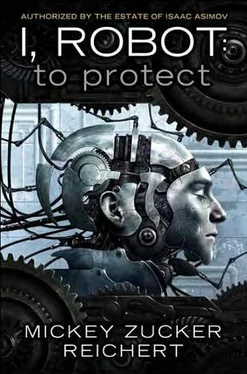It took four beeps before he answered. “Susan? Is everything all right?”
“Fine, Dad. I just wanted to ask you a question.”
“All right. But first, is Remy okay?”
Remington spoke up, “I’m fine, Dr. Calvin. Thank you for asking. I’m here with Susan.”
“Glad to hear it.” Calvin asked carefully, “Who else can hear us?”
Susan glanced around the room from habit, though she already knew the answer. “Just Nate, Dad. It’s only the three of us in a closed room.”
“Nate!” John Calvin said briskly. “How the hell are you?”
“Fine, Dr. Calvin.” Nate looked sheepishly at the resident doctors, as if concerned John Calvin sounded more excited about him than the humans. “A bit bored. When these two visit, it’s the best part of my day.”
“I feel the same way, Nate,” Susan’s father said.
Susan smiled at Remington. Her father had not actually met the neurosurgery resident yet, but Susan had talked about him in glowing terms. “We’re just wondering if the nanorobots have the Three Laws of Robotics embedded in them.”
“The nanorobots?” John Calvin seemed surprised by the question. “Well, they do have a rudimentary positronic brain. We can’t fit a whole lot of pathways in something that tiny, so we whittle it down to the basics.”
“Do the basics include the Three Laws of Robotics?” Susan persisted.
“Well, of course.” John Calvin sounded almost insulted by the question. “Nothing leaves U.S. Robots without those. Standard equipment.” He hesitated, and a hint of suspicion entered his voice. “Why do you ask?”
Susan glanced at each of her companions in turn. She saw no reason not to include her father in their speculation, but she did not want to do so against anyone else’s wishes. “We’re thinking Payton’s actions . . . seem to follow them. Parking near USR, but far enough to keep the explosion from collapsing the building. Letting off all the passengers . . .” Susan paused, expecting a reply.
John Calvin remained utterly silent.
Susan instinctively leaned closer to her Vox. “Dad? Did we lose you?”
The familiar voice issued from the device again. “No, I’m here. I’m just considering what you said.”
Remington stepped closer. “What do you think, sir?”
“For starters, I think you should call me John.”
Remington smiled. “All right, John. What do you think of the Three Laws theory?”
“I think . . . ,” he said, pausing, “that it’s an interesting idea, but it doesn’t really pan out. While the nanorobots do have the Laws embedded, as every USR product does, they don’t have the capacity to consider them.”
Susan believed she understood. “You mean, because of their microscopic size, they have only a fraction of the computational capacity of, say, a man-sized robot.”
John Calvin responded, “Exactly. The original wiring of the prototype positronic brain filled a large room. Over time, the brightest minds whittled it down to half, then a quarter, then an eighth. Nate’s positronic brain is only half again the size of a human male’s. We can get away with stuffing it into a normal-sized skull because he doesn’t need cerebrospinal fluid, cisterns, direct blood supply, or as much cushioning. It’s just skull, a thin layer of hair-growing skin, and the proper circuitry.”
Susan could not help examining Nate as her father described him. He looked, for all the world, like a normal man. Had he not told her weeks ago, she never would have imagined he was composed of plastic, steel, and wires bundled into an all-too-human framework. He seemed so spectacularly normal.
John continued. “Obviously, with the nanorobots, we take out everything nonessential: emotion, calculation, reason. We leave only what’s necessary for them to do their job, which consists of monitoring electronic activity and chemical composition of the cerebrospinal fluid and brain tissue. And, as you guessed, the Three Laws of Robotics. They remain embedded because our positronic brains cannot exist without them. It would violate the law, and our ethical code, to build even the most basic robot without them. It is the one and only process. All USR robotics begin and end with the Three Laws. It would be utterly impossible to build a positronic brain without the Three Laws or to remove them without permanently disabling the robot.”
Susan tried to make sense of Payton’s actions in the context of the current conversation. “So, what you’re saying is the nanorobots have the Three Laws embedded. However, they don’t have the capacity to act on them.”
Remington took it a step further. “They don’t have the capacity to act on anything except the task they were programmed to do. Even if they had the size, they don’t have the hardware to do anything more substantial than swim through bodily fluids. And they don’t have the intellectual capacity to . . .” There, his own knowledge ran short, so he finished by asking, “To what, sir?” Receiving no answer, he amended his question, “To what, John?”
Apparently satisfied, Susan’s father deigned to answer. “They have some intellectual capacity, some ability to learn and make basic decisions, such as to focus in on a location in the patient’s brain where neurons appear to be misfiring. But they’re not programmed to act, just to record. Their encoding is extremely passive. They don’t transmit; they only receive.”
Susan sighed, disappointed. Her theory had seemed so plausible, and she could not help feeling as if a small piece of herself had died with it. “So, it’s not possible to affect a person’s thoughts and actions with injected nanorobots.”
Nate finally spoke up. “Oh, it’s possible.”
All three humans fell silent. Susan could not help staring at the robot.
“Just not, as I am understanding it, with these particular nanorobots. I imagine a clever programmer could add a command and an interface to the human host.”
“Conceivable,” John Calvin said over the Vox, “but it would require someone with the knowledge of how to program them and the opportunity to tamper with them.”
Susan felt a lump growing in her throat. “Do you . . . do you know . . . someone like that?”
“No.” The answer came so swiftly, Susan did not believe he had had time to consider. “Alfred Lanning directly oversees this project. The company is the brainchild, the baby, of Alfred Lanning and Lawrence Robertson. Either one would sooner kill himself than put U.S. Robots at risk. At the other end, even if Goldman and Peters knew how to sabotage nanorobots, they’d never destroy their own reputations and careers. They’ve worked with us several times before; that’s why USR picked them. And they’re the primary force behind keeping Nate at the hospital.”
Susan shook her head. She knew Goldman, especially, wanted more robots in medical use; and she could never imagine Peters doing anything so harmful. He did not have it in him. Their joint insistence on Susan not mentioning anything about the experiment to the police clinched their innocence. “So, if tampering occurred, it would have to have happened somewhere between USR and the lab.”
“Susan, I like that you’re thinking.” Susan recognized the soothing, diplomatic tone John Calvin adopted when he tried to gently redirect her. “And I understand where you’re going.”
“But . . . ,” Susan added, trying not to sound defensive.
“Well . . .” A note of discomfort entered her father’s voice. He was a gentle man, not given to crushing ideas or dreams. “Some of the best minds in medicine and robotics have considered the situation, separately and together, and they have come to a conclusion.”
“Yes,” Susan coaxed.
“They strongly believe Payton acted in response to his very severe mental illness, his schizophrenia; and the nanorobots had nothing to do with it.”
Читать дальше












